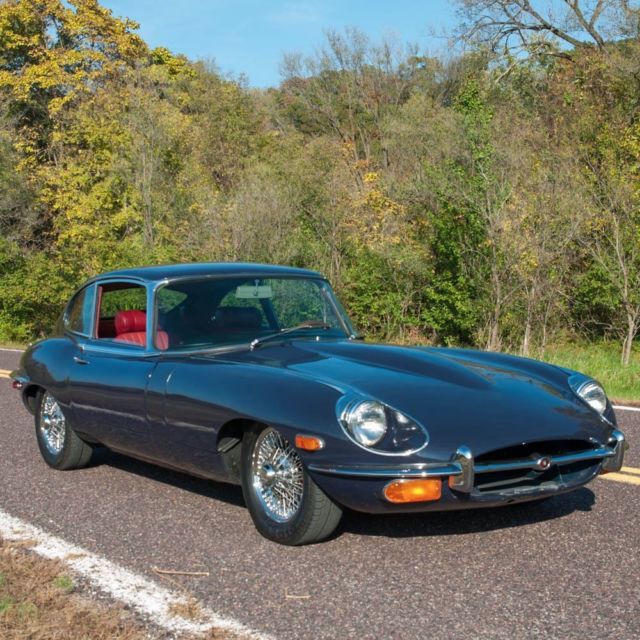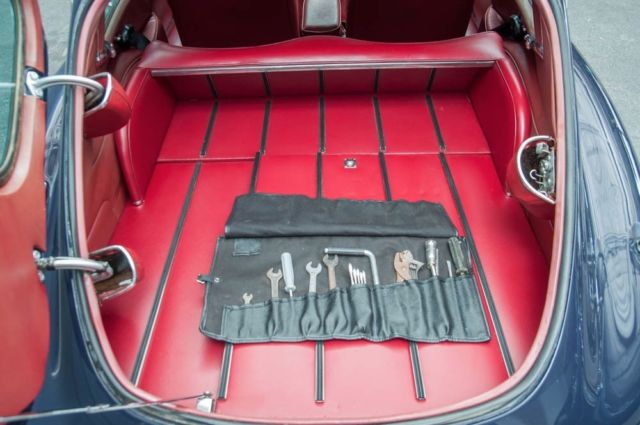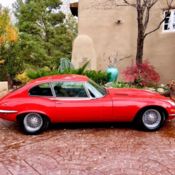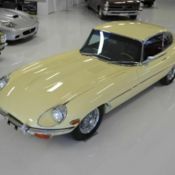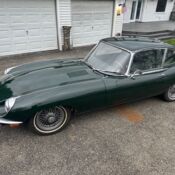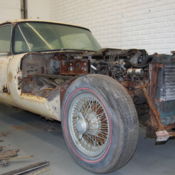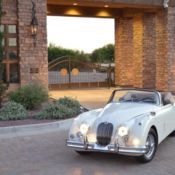1970 Jaguar XK-E 2+2 Coupe, Automatic, AC, New Tires, $24K in receipts! LOOK
1970 Jaguar XK XK-E 2+2 Coupe
1970 Jaguar E-Type 2+2 Coupe Description1970 Jaguar XK-E 2+2 Coupe
Two-owner car; previous owner drove it for almost 40 years! Dark blue exterior Red interior with matching Connolly Leather bucket seats and Wilton wool carpet One of 5,326 2+2 models made between 1968 and 1971 4.2L DOHC inline six-cylinder engine (246 hp) with dual Zenith-Stromberg 175 CDSE carburetors Three-speed automatic transmission Limited-slip rear differential Independent front and rear suspensions Power assisted rack-and-pinion steering and power four-wheel disc brakes Tilt steering column Air-conditioning New tires Philips AM/FM stereo Rear window defroster and tinted glass Nardi steering wheel Original, chrome 15-inch polished wire wheels and NOS Jaguar center lock hubs Car comes with more than $24K in maintenance receipts plus various insurance, license, registration and other documentsThe Jaguar XK-E’s combination of beauty, high performance and competitive pricing established the marque as an icon of 1960s motoring. MotoeXotica Classic Cars is pleased to present this original, unmolested and seldom-seen 1970 Jaguar XK-E 2+2 coupe. Its previous local owner drove it for almost 40 years! The body is 9 in (229 mm) longer than the standard fixed head coupe and the roof angles are different.
Outside, the car’s dark blue paint is in good overall condition and the windshield and other glass sections are intact, clear and look good, considering their age. The car rolls on Pirelli P600 Sport Veloce radial tires, 195/65R15, which surround wire wheels with NOS Jaguar wheel hex caps. All body panels are laser straight and solid. The underside of this handsome cat is solid with some repair evident on the rocker panels but does not limit this Jag and is a wonderful driver with long term extensive history!
The power is transferred to the rear wheels by a three-speed automatic transmission backed to a limited-slip rear differential. The driver assist features include power assisted rack-and-pinion steering, four-wheel power disc brakes and independent front and rear suspensions. Included are the original chrome 15-inch polished wire wheels and Jaguar center lock hubs.
Inside, the recently recovered Connolly Leather red seats look fantastic as a contrast to the dark blue paint. The Wilton carpet, headliner and dashboard, a Nardi wood-rimmed steering wheel, complete with Enrico Nardi’s autograph on the three o’clock spoke, center console with armrest and shift lever look similarly good and help complete the period appearance. There’s a very rare and handsome Philips AM/FM/SW (shortwave) stereo in the dashboard.
A Mr. Mayer of Pacific, Missouri, bought the car in 1977 from the original owner it is a highly documented car with the paperwork we received, he had the following work performed on this car:
In October 1977, he had the transmission fluid flushed, bands adjusted plus he had the transmission regulator replaced. He had the carburetors synchronized and the cooling system flushed. He had the radio serviced, a door seal replaced and left-hand lamp and lens replaced. In December of 1977, he had the power steering pump and temperature gauge sending unit replaced. In February of 1978, he had the angle drive replaced. In June 1978, he had the disc brakes, mufflers and intermediate pipes and cam cover gaskets replaced, a lube, oil and filter change done, recharged the air conditioning and replaced points, condenser and spark plugs and in March 1979, he had chrome moldings installed around rear window and windshield.
In February 1980, he had new front brake rotors and pads installed. In August of 1980, he had the charging system checked and two accessory drive belts replaced. In January 1982, he had a new exhaust connecting pipe installed. In April 1982, he had front brake work performed – rotors turned, calipers rebuilt and new pads installed. In June 1982, he ordered a new headliner. In July 1982, he had the headliner installed and the side trim and sun visors recovered. In October 1982, he bought a foot pump and oil filter. In August 1983, he had the exhaust pipes replaced. In October 1983, he had the distributor cap, rotor and battery replaced. In March 1984, he had the dash repaired and upholstered. In November of 1986, he had the oil element replaced. In January 1987, he had a lamp lens replaced. In February 1987, he had the rear hatch seal replaced, new bumper and bumper guards ordered, plus new bumper overriders, new motif back plate and emblem, among other items. In March 1987, he had a radiator hose and clamps, a relay and fuse packs, the blower motor replaced and the heater core boiled out. In April 1987, he had the Philips AM/FM/SW stereo disassembled and analyzed for short circuits. In June 1988, he had the coolant flushed and refilled and in June and July, 1989, he had the following work performed – a rebuilt power steering rack installed, alignment, reset toe-in to specifications, replaced engine fan otter switch.
In July 1990, he had a repair made to the windshield. In August 1990, he had an A/C hose replaced, freon and compressor lubricant added to the air conditioner, then the system was recharged. In May 1991, he had the oil and filter changed. In September 1994, he had miscellaneous parts replated. In March 1995, he had the car completely repainted. In May 1995, he had a new exhaust system installed. In August 1996, he the front brakes rebuilt. In April, 1997, he had the front bucket seats reupholstered and re-dyed. In July 1998, he had new hoses and motor mounts put in and the transmission’s front seal checked. He also had the engine overhauled. In October 1998, he had major service work performed. He had the crankshaft reground and replaced or added the following items – oil filter, exhaust valves, lower timing chain, engine stabilizer, carburetor tune-up kit, oil slinger, engine front main seal, diaphragm bypass, crank plug, connecting rod bearing, cam bearing, main bearings, hose filter, oil pan, piston ring set. That month, he had transmission rebuilt, transmission fluid flushed, new clutch bands installed and in July 1999, he had the engine manifolds replaced.
In August of 2000, he ordered new seat hinge covers, an air filter and pin and spring bushings for the rear differential. He also had the headliner and cover side rails replaced. In August 2001, he had the engine’s intake and exhaust valves adjusted, replaced points, condenser, new gaskets, new coolant, repaired oil breather, among other repairs. In April 2002, he had the transmission fluid changed. In August 2003, he had interior upholstery and trim work completed. In October 2003, he purchased four new tires and he also ordered a new window for the rear hatch, a hatch seal, door lock cylinder and related parts. In April 2004, he had the tires spin balanced, mounted and added new valve stems In October 2004, he had the car’s oil and filter changed and the chassis lubricated. In February 2005, he ordered a set of black rubber floor mats and four NOS wheel hex caps. In October 2006, he ordered brake fluid, front seat hinge covers and hinges and an oil filter. He had the oil and oil filter changed in April 2008. In July of 2010, he ordered two front brake rotors. The following month, he had the front brake calipers rebuilt. In October of 2010, he had a new brake rotor replaced plus new brake pads on both sides and front brake hoses. In August of 2011, he had a new distributor cap and rotor installed, plus a choke placard. In July of 2012, he had two new seat cushion foam pieces replaced. In August of 2012 he had a new seat cover kit installed and In October of 2012.
The Series 2 Jaguar introduced a number of design changes, largely due to U.S. legislation. The most distinctive exterior feature is the absence of the glass headlight covers. Unlike other cars, this retrograde step was applied worldwide for the E-Type, not just to Americans living under the authority of the National Highway Traffic and Safety Administration.
Other hallmarks of Series 2 cars are a wrap-around rear bumper, re-positioned and larger front indicators and tail lights below the bumpers, an enlarged “mouth,” which aided cooling but detracted for the Series I design purity, twin electric fans, plastic rocker switches in place of the Series I toggle switches.
A combination steering lock and ignition key was fitted to the steering column, which replaced the dashboard mounted ignition switch and charismatic push button starter. A new steering column was fitted with a collapsible section in the event of an accident. Air conditioning and power steering were available as factory options.
New seats were fitted which allowed head restraints, as required by U.S. law beginning in 1969. The interior and dashboard were also redesigned; rocker switches that met US health and safety regulations were substituted for toggle switches. The dashboard switches also lost their symmetrical layout.
The 4.2-liter version of the XK was officially released in 1964, although racers had been boring the 3.8 out all the way to 4.2 liters for years. The factory 4.2-liter block was a new siamesed sleeve design which used re-spaced cylinders set unevenly along the length of the block with new main bearing spacings and a new crankshaft. The middle two cylinders were moved closer together and the outer two moved further apart but the overall length of the block remained unchanged. This enabled the cylinder bores to be taken out to 3.6 in while retaining the familiar long stroke of 4.2 in for a total displacement of 258 CID.
Despite the re-spacing of the cylinder bores, the cylinder head castings remained unchanged. As a result, the centerlines of the combustion chambers in the head no longer aligned precisely with the centerlines of the cylinders but this did not matter greatly as the combustion chamber diameters in the head were smaller than the cylinder diameters. The 3.8 and 4.2-litre cylinder heads and cams are therefore interchangeable. The 4.2-litre engine from the factory had unsmoothed steps between the inlet manifold and head and the manifold gaskets were not a good match for the inlet ports. These engines therefore make excellent bases for some modification, achieving approximately 220 horsepower and increased torque merely by “flowing” the head.
Examples of this Jaguar’s competition in 1970 included the Citroen SM, the BMW 2800 CS and the Mercedes-Benz 280 SL.
Probably one of the most recognizable coupes ever produced, Enzo Ferrari called it “The most beautiful car ever made,” this low mileage, largely un-restored original E-type is the ideal combination of style, function and performance…and with the endorsement of Enzo Ferrari, what are you waiting for? GET OUT AND DRIVE!!!
Current mileage on the odometer shows 63,953 miles. It is sold as is, where is on a clean and clear, mileage exempt title with mileage understood to be actual and receipts/records to back up the current shown mileage.
VIN: 1R42577BW
Note: Please see full terms and conditions listed below that pertain to the purchase of any said vehicle, thank you.
- Make: Jaguar
- Model: XK
- SubModel: XK-E 2+2 Coupe
- Type: Coupe
- Trim: XK-E 2+2 Coupe
- Year: 1970
- Mileage: 63,953
- VIN: 1R42577BW
- Color: Dark Blue
- Engine size: 4.2L inline 6
- Number of cylinders: 6
- Transmission: Automatic
- Drive type: RWD
- Interior color: Red Connolly Leather
- Vehicle Title: Clear Want to buy? Contact seller!
